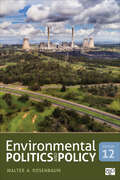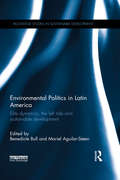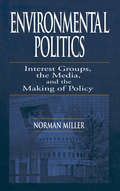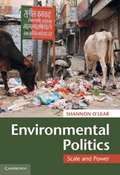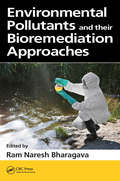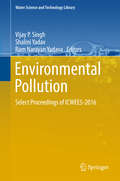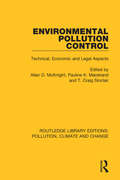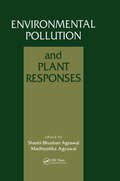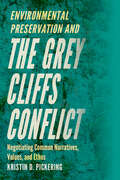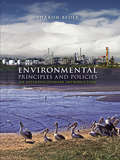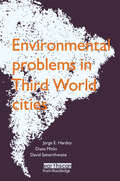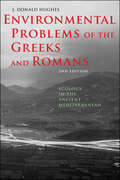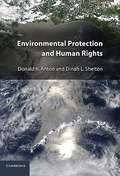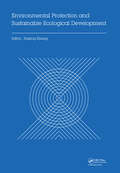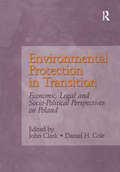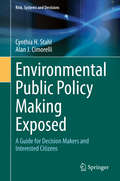- Table View
- List View
Environmental Politics and Policy
by Walter A. RosenbaumWalter A. Rosenbaum′s classic Environmental Politics and Policy, Twelfth Edition, provides definitive coverage of environmental politics and policy, lively case material, and a balanced assessment of current environmental issues. The newly streamlined first half of the book sets needed context and describes the policy process, while the second half covers specific environmental issues such as air and water, toxic and hazardous substances, energy, and global policymaking on issues like climate change and trans-boundary politics. The Twelfth Edition includes updated case studies and a look at the transition in environmental policies between the Trump and Biden administrations, offering students a current and relevant look at the continuing challenge of reconciling sound science with practical politics.
Environmental Politics in Latin America: Elite dynamics, the left tide and sustainable development (Routledge Studies in Sustainable Development)
by Benedicte Bull Mariel Cristina Aguilar-StoenSince colonial times the position of the social, political and economic elites in Latin America has been intimately connected to their control over natural resources. Consequently, struggles to protect the environment from over-exploitation and contamination have been related to marginalized groups’ struggles against local, national and transnational elites. The recent rise of progressive, left-leaning governments – often supported by groups struggling for environmental justice – has challenged the established elites and raised expectations about new regimes for natural resource management. Based on case-studies in eight Latin American countries (Argentina, Brazil, Chile, Ecuador, Colombia, Bolivia, El Salvador and Guatemala), this book investigates the extent to which there have been elite shifts, how new governments have related to old elites, and how that has impacted on environmental governance and the management of natural resources. It examines the rise of new cadres of technocrats and the old economic and political elites’ struggle to remain influential. The book also discusses the challenges faced in trying to overcome structural inequalities to ensure a more sustainable and equitable governance of natural resources. This timely book will be of great interest to researchers and masters students in development studies, environmental management and governance, geography, political science and Latin American area studies.
Environmental Politics: Interest Groups, the Media, and the Making of Policy
by Norman MillerAt every stage, environmental policy is the result of the combat of stakeholders interested in, and affected by, the problem being addressed and the range of possible solutions. The combatants include any or all of the following: the federal government, environmental advocacy groups, and business, the media, the scientific community, think tanks, NGOs of every stripe, trade associations and professional organizations, and even state and local governments, each of whom have their own interests in the resulting policy. Environmental Politics: Interest Groups, the Media, and the Making of Policy discusses political battles over the environment from ground level - as they are fought in legislative chambers, the daily newspaper, on television, and, increasingly, on the Internet. The text explores environmental politics as a clash of interests, not ideologies, and environmental policy as a result of the reconciliation of those interests.
Environmental Politics: Scale and Power
by Shannon O'LearShannon O'Lear brings a geographer's perspective to environmental politics. The book considers issues of climate change, energy, food security, toxins, waste, and resource conflict to explore how political, economic, ideological and military power have contributed to the generation of environmental issues and the formation of dominant narratives about them. The book encourages the reader to think critically about the power dynamics that shape (and limit) how we think about environmental issues and to expand the reader's understanding of why it matters that these issues are discussed at particular spatial scales. Applying a geographer's sense of scale and power leads to a better understanding of the complexity of environmental issues and will help formulate mitigation and adaptation strategies. The book will appeal mainly to advanced students and researchers from a geography background, but also to social and political scientists who wish to look at the topic from this different perspective.
Environmental Politics: Stakeholders, Interests, and Policymaking
by Norman MillerThe second edition of Environmental Politics: Stakeholders, Interests, and Policymaking shows students that environmental politics is fundamentally a clash of competing stakeholders’ interests, and environmental policy the result of their reconciliation. But developments in environmental policymaking over the past several years have been little short of earthshaking. The text not only marks changes in the formal lawmaking process itself, but covers recent elements reshaping environmental politics, such as: the new environmentally activist posture of business the dramatic shift of policymaking influence from the federal to state and local levels the participation of new actors on the environmental policy stage, most notably the faith community the U-turn of organized labor, from opponent of environmentalists to their collaborator the consolidation of the varying missions of environmental advocacy groups to fight global warming the emergence of science from its historic political neutrality to open advocacy the increasing role of both the media and the judiciary Written by an expert with more than 25 years of "smoke-filled room" experience in environmental policymaking, Environmental Politics: Stakeholders, Interests, and Policymaking gives students an insider's view of how policies are forged. By examining current environmental issues through a stakeholder lens, this book not only provides a unique perspective into how policies are adopted, but also illuminates the transformative power of global warming as a political force.
Environmental Pollutants and their Bioremediation Approaches
by Ram Naresh BharagavaThis book is a compilation of detailed and latest knowledge on the various types of environmental pollutants released from various natural as well as anthropogenic sources, their toxicological effects in environments, humans, animals and plants as well as various bioremediation approaches for their safe disposal into the environments. In this book, an extensive focus has been made on the various types of environmental pollutants discharged from various sources, their toxicological effects in environments, humans, animals and plants as well as their biodegradation and bioremediation approaches for environmental cleanup.
Environmental Pollution
by Vijay P Singh Shalini Yadav Ram Narayan YadavaThis book comprises select proceedings of the International Conference on Water, Environment, Energy and Society. The book is divided into five parts. The first part deals with some aspects of environmental pollution such as socio-economic environment assessment for sustainable development, environmental issues due to fire in coal Mines and its impact and suggestions for implementing precautionary and control measures, redevelopment of urban slum dwellings: issues & challenges, air and noise pollution in mega cities, importance of indoor environmental quality in green buildings. Part II discusses pollution indicators such as assessment and prediction of environmental noise, fuzzy logic based performance evaluation, fish biodiversity and its periodic reduction, effects of anthropogenic activities on fresh water ecosystems, and monitoring of air pollution. Part III focuses on generation of pollution namely biomedical waste generation and management, heavy metal leaching, etc. Water quality assessment is described in Part IV. The Part V presents water quality modeling. The book will be of interest to researchers and practitioners in the field of water resources, hydrology, environmental resources, agricultural engineering, watershed management, earth sciences, as well as those engaged in natural resources planning and management. Graduate students and those wishing to conduct further research in water and environment and their development and management will also find the book to be of value.
Environmental Pollution Control: Technical, Economic and Legal Aspects
by Allan D. McKnight Pauline K. Marstrand T. Craig SinclairOriginally published in 1974 this volume brings together contributions from lawyers, a nuclear physicist, a landscape architect, biologist, engineers and a former Inspector of the International Atomic Energy Agency. It covers technical and legal information on air, water, sea, land and noise pollution and provides a comprehensive guide, summary and introduction to the journal literature in separate but relevant disciplines. All of the contributors have specialised in studies in pollution control and contributed to the debate on use and management of the environment.
Environmental Pollution and Community Rebuilding in Modern Japan
by Keiji Fujiyoshi Masafumi Yokemoto Miho Hayashi Mayuko ShimizuThis book describes how modern industry affected people in Japan and their communities by polluting their living environment with toxic emissions. It also shows how the populace endeavored not only to restore their once-clean environment but also to rebuild communities that had been damaged by pollution and its accompanying effects. Environmental pollution is usually referred to in Japan as kogai, public damage, meaning that such pollution not only harms the physical environment—air, water, soil, and the human body—but also destroys the social and personal relationships in the polluted area. Those people who took action recognized that industrial and economic development had been given the highest national priority even at the cost of their health and welfare. In this sense, anti-kogai movements led them to alternative community development and to rethinking what kind of environment and community they wanted. This book also explores the efforts driven by residents in several parts of Japan after the middle of the twentieth century and the endeavors of museums and archives as a memorial to those who suffered from the pollution and for the prospect of a better society with a good environment.
Environmental Pollution and Plant Responses
by Madhoolika Agrawal Shashi Bhushan AgrawalComprehensive and global in scope, Environmental Pollution and Plant Responses provides an analysis of the research on the factors contributing to the deteriorating environmental quality and its effect on plant performance. The issues include: environmental pollution and global climate change, response patterns of plants at different levels, mechanisms of interaction, tolerance strategies and future research prospects. The author evaluates trends and gives management strategies for abating the problem. This volume highlights the complexities of environmental problems and the affect of pollution on every level of the ecosystem.
Environmental Pollution in China: What Everyone Needs to Know (What Everyone Needs To Know)
by Daniel K. GardnerChina suffers from a range of environmental pollution problems: air, water, soil, electronic waste, noise, and light. But air, water, and soil pollution and the scourge of electronic waste have been the most environmentally costly and have had the most dramatic effects on public health. In Environmental Pollution in China: What Everyone Needs to Know, Daniel K. Gardner examines the range of factors -- economic, social, political, and historical -- contributing to the degradation of China's environment. He also covers the public response to the widespread pollution; the measures the government is taking to clean up the environment; and the country's efforts to lessen its dependence on fossil fuels and develop clean sources of energy. Concise, accessible, and authoritative, this book serves as an ideal primer on one of the world's most challenging environmental crises.
Environmental Practice and Early American Literature
by Michael ZiserThis original and provocative study tells the story of American literary history from the perspective of its environmental context. Weaving together close readings of early American texts with ecological histories of tobacco, potatoes, apples, and honey bees, Michael Ziser presents a method for literary criticism that explodes the conceptual distinction between the civilized and natural world. Beginning with the English exploration of Virginia in the sixteenth century, Ziser argues that the settlement of the "New World" - and the cultivation and exploitation of its bounty - dramatically altered how writers used language to describe the phenomena they encountered on the frontier. Examining the work of Harriot, Grainger, Cooper, Thoreau and others, Ziser reveals how these authors, whether consciously or not, transcribed the vibrant ecology of North America, and the ways that the environment helped codify a uniquely American literary aesthetic of lasting importance.
Environmental Preservation and the Grey Cliffs Conflict: Negotiating Common Narratives, Values, and Ethos
by Kristin D. PickeringBased on a qualitative, ethnographic, observational case study approach, Environmental Preservation and the Grey Cliffs Conflictpresents an analysis of the conflict negotiation between the U.S. Army Corps of Engineers and a local community that struggled to address a deteriorating Corps-managed recreational lake area in Tennessee known as “Grey Cliffs.” Viewing the dispute from the perspective of a new member of the community and a specialist in technical communication and professional writing, Kristin Pickering provides a unique perspective on this communication process. Though environmental degradation and unauthorized use threatened the Grey Cliffs recreational lake area to the point that the Corps considered closure, community members valued it highly and wanted to keep it open. The community near this damaged and crime-ridden area needed help rejuvenating its landscape and image, but the Corps and community were sharply divided on how to maintain this beloved geographic space because of the stakeholders’ different cultural backgrounds and values, as well as the narratives used to discuss them. By co-constructing and aligning narratives, values, and ethos over time—a difficult and lengthy process—the Corps and community succeeded, and Grey Cliffs remains open to all. Focusing on field notes, participant interviews, and analysis of various texts created throughout the conflict, Pickering applies rhetorical analysis and a grounded theory approach to regulation, identity, sustainability, and community values to analyze this communication process. Illustrating the positive change that can occur when governmental organizations and rural communities work together to construct shared values and engage in a rhetoric of relationship that preserves the environment, Environmental Preservation and the Grey Cliffs Conflict provides key recommendations for resolving environmental conflicts within local communities, especially for those working in technical and professional communication, organizational communication, environmental science, and public policy.
Environmental Principles and Policies: An Interdisciplinary Introduction
by Sharon BederEnvironmental Principles and Policies uses environmental and social principles to analyse the latest wave of economic-based and market-orientated environmental policies currently being adopted around the world. This book provides an in-depth examination of six key principles that have been incorporated into international treaties and the national laws of many countries: * ecological sustainability * the polluter pays principle * the precautionary principle * equity * human rights * public participation These principles are then used to evaluate a range of policies including pollution charges, emissions, trading, water markets, biodiversity banks and tradable fishing rights. Environmental Principles and Policies is easily accessible, using non-technical language throughout, and - in what sets it apart from other books on environmental policy-making - it takes a critical and interdisciplinary approach. It does not set out policies in a descriptive or prescriptive way, but analyses and evaluates policy options from a variety of perspectives. This enables readers to gain a thorough grasp of important principles and current policies, as well as demonstrating how principles can be used to critically assess environmental policies.
Environmental Problems in Third World Cities
by David Satterthwaite Diana Mitlin Jorge E. HardoyDescribes and analyses the environmental problems of Third World cities, showing how they affect human health and the local ecology. The authors show how readily available practical solutions are, if the political means can be found.
Environmental Problems of the Greeks and Romans: Ecology in the Ancient Mediterranean (Ancient Society and History)
by J. Donald HughesHow did ancient societies change the environment and how do their actions continue to affect us today?In this dramatically revised and expanded second edition of the work entitled Pan’s Travail, J. Donald Hughes examines the environmental history of the classical period and argues that the decline of ancient civilizations resulted in part from their exploitation of the natural world. Focusing on Greece and Rome, as well as areas subject to their influences, Hughes offers a detailed look at the impact of humans and their technologies on the ecology of the Mediterranean basin. Evidence of deforestation in ancient Greece, the remains of Roman aqueducts and mines, and paintings on centuries-old pottery that depict agricultural activities document ancient actions that resulted in detrimental consequences to the environment. Hughes compares the ancient world's environmental problems to other persistent social problems and discusses attitudes toward nature expressed in Greek and Latin literature. In addition to extensive revisions based on the latest research, this new edition includes photographs from Hughes's worldwide excursions, a new chapter on warfare and the environment, and an updated bibliography.
Environmental Process and Production Methods (European Yearbook of International Economic Law #3)
by David SifoniosThis book examines the conditions under which PPM measures may be adopted under WTO law de lege lata and de lege ferenda. It analyses in detail the complex case law in this field and its evolution in the last 25 years, as well as the many doctrinal debates around PPM measures and their relevance in the light of the evolution of case law, both under the GATT and the TBT Agreement. Further, it also suggests an original approach to the interpretation of the relevant provisions of the GATT and the TBT Agreement in the context of PPM measures. The PPM issue has been one of the most debated topics in the trade and environment debate. Even though the US-Shrimp case showed that PPM measures are not prohibited per se under the GATT, many questions remain unanswered when it comes to the precise conditions under which environmental PPM measures are justifiable under WTO law, for example in the field of trade measures relating to climate change mitigation efforts, natural resources management policies and biodiversity conservation measures.
Environmental Project Management
by Joseph L. Awange Ebenezer A. SholarinThis book offers a new framework that facilitates the development of more intelligent systems and methods for data analysis and international information sharing, such as the use of satellite imaging and geospatial data to predict changes in weather conditions and shifts in water levels, and to assess the extent of the forest cover remaining on Earth that is visible from space. It brings together the many aspects of science and technology, as well as formula and analytical approaches required for more informed decision-making. It also highlights the vital importance of understanding the technological, economic and social dimensions of environmental projects that have short-term results and long-term impacts. It is unique in that it clearly distinguishes between environmental project management (EnvPM) and green project management (GreenPM), and presents an amalgamation of environmental management and project management concepts, using geospatial methods to form an EnvPM concept. The book sets a benchmark for the professionalism with which environmental projects should be planned, executed, monitored, assessed and delivered. While primarily intended for professionals responsible for the management of environmental projects or interested in improving the overall efficiency of such projects, it is also a useful handbook for managers in the private, public and non-for-profit sectors. It is a valuable resource for students at both undergraduate and master's levels and an indispensable guide for anyone wanting to develop their skills in modern project management, environmental management and geospatial techniques. ``We are the first generation to feel the impact of climate change, and the last generation that can do something about it. '' US President Obama's address to the United Nations on Climate Change and Global warming (2015) hison: This book provides an in-depth, well-researched and science-based approach to applying key project-management and spatial tools and practices in environmental projects. An important read for leaders considering projects that balance social-economic growth against minimising its ill-effects on Planet Earth. - Todd Hutchison, Global Chairman of Peopleistic group.
Environmental Protection and Human Rights
by Donald K. Anton Dinah SheltonWith unique scholarly analysis and practical discussion, this book provides a comprehensive introduction to the relationship between environmental protection and human rights being formalized into law in many legal systems. This book instructs on environmental techniques and procedures that assist in the protection of human rights. The text provides cogent guidance on a growing international jurisprudence on the promotion and protection of human rights in relation to the environment that has been developed by international and regional human rights bodies and tribunals. It explores a rich body of case law that continues to develop within states on the environmental dimension of the rights to life, to health, and to public participation and access to information. Five compelling contemporary case studies are included that implicate human rights and the environment, ranging from large dam projects to the creation of a new human right to a clean environment.
Environmental Protection and Sustainable Ecological Development: Proceedings of the 2014 International Conference on Environmental Protection and Sustainable Ecological Development (EPSED 2014), Wuhan, Hubei, China, October 24-26, 2014
by Jiaxing ZhangThis volume contains the papers presented at the 2014 International Conference on Environmental Protection and Sustainable Ecological Development (EPSED2014). The contributions cover the latest research results and explore new areas of research and development, like Earth Science, Resource Management, Environmental Protection, and Sustainable
Environmental Protection in Transition: Economic, Legal and Socio-Political Perspectives on Poland
by John Clark Daniel H. ColeThis book takes an interdisciplinary look at environmental protection during Poland’s transition to market democracy. The contributors are recognised experts in their fields, making this an authoritative volume, combining the perspectives of economists, legal scholars, political scientists and sociologists.
Environmental Protection, China and International Trade: Greening the WTO Ban on Chinese Export Duties (The Rule of Law in China and Comparative Perspectives)
by Fengan JiangThis book argues for a balanced approach to ‘greening’ the World Trade Organization (WTO) ban on China’s export duties without opening the floodgates to protectionism. As a result of the China—Raw Materials and China—Rare Earths decisions, China is largely prohibited from using export duties to address environmental problems, including those associated with climate change. This is despite a number of climate studies having suggested that Chinese export duties could be useful for reducing carbon leakage, an issue of international concern. This book puts the case for a more balanced approach. It shows that a harsh ban on China’s export duties constrains its policy space to protect the environment, particularly in the context of climate change. The work presents feasibility tests for various legal solutions that have been discussed for adjusting the ban, and it accordingly proposes a more feasible approach that would allow China to help protect the environment without advancing protectionism. The proposed legal option provides a less protectionist alternative to export duties, namely ‘export duties plus’: export duties in combination with supplementary restrictions on Chinese consumption. This analysis also yields insights regarding ways to correct WTO precedents, which suggests a moderate alternative response to an important issue behind the Appellate Body crisis. The book will be a valuable resource for academics, researchers and policymakers in the areas of International Trade Law, Environmental Law and China.
Environmental Public Interest Litigation in China
by Xiaobo Zhao Xi Wang Noeleen McNamaraThis book offers readers an accessible and broad-ranging guide to Environmental Public Interest Litigation (EPIL), which has burgeoned in China over the past decade. The aim of this book is to provide a systematic review of Chinese experiences with EPIL in environmental matters, both with a view to gauging its success to date and well as discussing some more critical aspects. To this end, the book systematically examines the establishment and development of EPIL in China's legal, social, and political contexts. It examines particularly the significant role and functions of EPIL in China's environmental governance, and the far-reaching impacts on Chinese civil society and governments. It also offers readers an insiders' perspective in terms of procedural and substantive issues with respect to EPIL, by reviewing the institutional designs, theoretical underpinnings and specific mechanisms, the roles of various participants and stakeholders involved in this legal process. At the same time, it studies leading EPIL cases raised from environmental pollution, natural resource damage and ecological damage, and the effectiveness of environmental adjudication that sustains EPIL as a new form of judicial instrument. This book is written to remedy the gap between Chinese and English literature in this area of law. The analysis of these issues, through a historic and comparative perspective, reveals the strengths and weaknesses of the current legal regime and serves as a basis for recommendations for bringing about more effective EPIL in China.
Environmental Public Policy Making Exposed: A Guide for Decision Makers and Interested Citizens (Risk, Systems and Decisions)
by Cynthia H. Stahl Alan J. CimorelliThis book exposes the barriers to inclusive and effective public policy making, which are the current decision making paradigm and commonly held ideas that reduce public policy problems to scientific and technical ones. Through both environmental policy and other decision making examples, readers are shown the commonalities of all decision making. Solution-oriented practitioners and stakeholders will find this book filling a conceptual and methodological gap in existing policy literature and practice. The authors deftly guide readers from post-normal science, wicked problems, and uncertainty concepts to a conceptually-grounded, practical implementation of a new approach, the open solution approach. The Multi-criteria Integrated Resource Assessment (MIRA) is described as the first generation methodology that fulfills the expectations for the inclusive, transparent, and learning-based open solutions approach. MIRA is a holistic package of concepts, methods and analytical tools that is designed to assess Decision Uncertainty, the combined uncertainties that include data, problem formulation, expert judgments, and stakeholder opinions. Introduction of the Requisite Steps, the common steps found in all decision making, provides the yardstick for evaluating a variety of decision making processes, decision tools, and commonly found indices such as the Dow Jones Industrial Average or the Newsweek Green Ranking of corporations. The use of anecdotes, policy stories, and case examples makes this a very readable and practical book for citizens and experts. With this book, readers are prepared to critically evaluate these common indices for their personal use as well as challenge policy processes as a stakeholder. For policy practitioners, this guidebook will become a rubric to ensure an effective public policy making process and to critically evaluate decision support tools.
Environmental Realism
by Melanie Armstrong Kristan Cockerill Jennifer Richter Jordan G. OkieThis interdisciplinary book challenges current approaches to "environmental problems" that perpetuate flawed but deeply embedded cultural beliefs about the role of science and technology in society. The authors elucidate and interrogate a cultural history of solutionism that typifies expectations that science can, should, and will reduce risk to people and property by containing and controlling biophysical phenomena. Using historical analysis, eco-evolutionary principles, and case studies on floods, radioactive waste, and epidemics, the authors show that perceived solutions to "environmental problems" generate new problems, leading to problem-solution cycles of increasing scope and complexity. The authors encourage readers to challenge the ideology of solutionism by considering the potential of language, social action and new paradigms of sustainability to shape management systems. This book will appeal to scholars in multi- and interdisciplinary fields such as Environment Studies, Environmental Science, Environmental Policy, and Science, Technology, and Society Studies.
